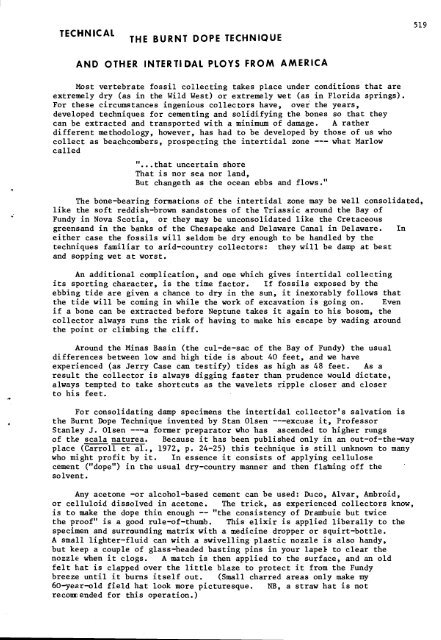E;*+ - Geological Curators
E;*+ - Geological Curators
E;*+ - Geological Curators
You also want an ePaper? Increase the reach of your titles
YUMPU automatically turns print PDFs into web optimized ePapers that Google loves.
-.<br />
THE BURNT DOPE TECHNIQUE<br />
AND OTHER INTER'TIDAL PLOYS FROM AMERICA<br />
Most vertebrate fossil collecting takes place under conditions that are<br />
extremely dry (as in the Wild West) or extremely wet (as in Florida springs).<br />
For these circumstances ingenious collectors have, over the years,<br />
developed techniques for cementing and solidifying the bones so that they<br />
can be extracted and transported with a minimum of damage. A rather<br />
different methodology, however, has had to be developed by those of us who<br />
collect as beachcombers, prospecting the intertidal zone --- what Marlow<br />
called<br />
"...that uncertain shore<br />
That is nor sea nor land,<br />
But changeth as the ocean ebbs and flows."<br />
The bone-bearing formations of the intertidal zone may be well consolidated,<br />
like the soft reddish-brown sandstones of the Triassic around the Bay of<br />
Fundy in Nova Scotia, or they may be unconsolidated like the Cretaceous<br />
greensand in the banks of the Chesapeake and Delaware Canal in Delaware. In<br />
either case the fossils will seldom be dry enough to be handled by the<br />
techniques familiar to arid-country collectors: they will be damp at best<br />
and sopping wet at worst.<br />
An additional complication, and one which gives intertidal collecting<br />
its sporting character, is the time factor. If fossils exposed by the<br />
ebbing tide are given a chance to dry in the sun, it inexorably follows that<br />
the tide will be coming in while the work of excavation is going on. Even<br />
if a bone can be extracted before Neptune takes it again to his bosom, the<br />
collector always runs the risk of having to make his escape by wading around<br />
the point or climbing the cliff.<br />
Around the Minas Basin (the cul-de-sac of the Bay of Fundy) the usual<br />
differences between low and high tide is about 40 feet, and we have<br />
experienced (as Jerry Case can testify) tides as high as 48 feet. As a<br />
result the collector is always digging faster than prudence would dictate,<br />
always tempted to take shortcuts as the wavelets ripple closer and closer<br />
to his feet.<br />
For consolidating damp specimens the intertidal collector's salvation is<br />
the Bumt Dope Technique invented by Stan Olsen ---excuse it, Professor<br />
Stanley J. Olsen ---a former preparator who has ascended to higher rungs<br />
of the scala naturea. Because it has been published only in an out-of-the-way<br />
place (Carroll et al., 1972, p. 24-25) this technique is still unknown to many<br />
who might profit by it. In essence it consists of applying cellulose<br />
cement ("dope") in the usual dry-country manner and then flafning off the<br />
so lven t.<br />
Any acetone -or alcohol-based cement can be used: Duco, Alvar, Ambroid,<br />
or celluloid dissolved in acetone. The trick, as experienced collectors know,<br />
is to make the dope thin enough -- "the consistency of Drambuie but twice<br />
the proof" is a good rule-of-thumb. This elixir is applied liberally to the<br />
specimen and surrounding matrix with a medicine dropper or squirt-bottle.<br />
A small lighter-fluid can with a swivelling plastic nozzle is also handy,<br />
but keep a couple of glass-headed basting pins in your lapel! to clear the<br />
nozzle when it clogs. A match is then applied to the surface, and an old<br />
felt hat is clapped over the little blaze to protect it from the Fundy<br />
breeze until it bums itself out. (Small charred areas only make my<br />
60year-old field hat look more picturesque. NB, a straw hat is not<br />
recom ended for this operation. )

















